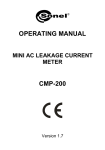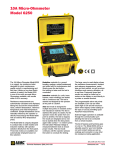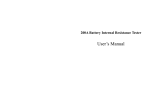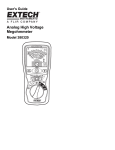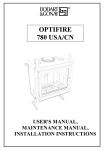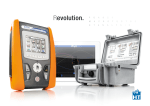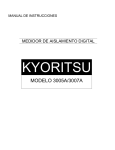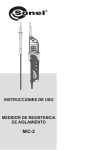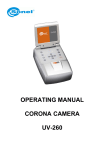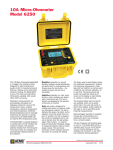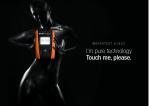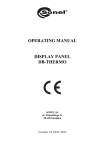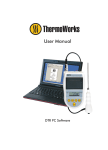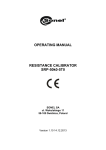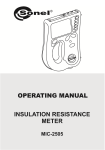Download MIC-2 ins obs v1.7 ang
Transcript
OPERATING MANUAL INSULATION RESISTANCE METER MIC-2 SONEL S. A. ul. Wokulskiego 11 58-100 Świdnica Version 1.7 11.03.2010 We appreciate your having purchased our insulation resistance meter. The MIC-2 meter is a modern measuring device, which is easy and safe to use. Please acquaint yourself with the present manual in order to avoid measuring errors and prevent possible problems related to operation of the meter. TABLE OF CONTENTS 1 SAFETY ............................................... 4 2 MEASUREMENTS ............................. 5 2.1 INSULATION RESISTANCE MEASUREMENTS ........................ 6 2.2 CONNECTION RESISTANCE MEASUREMENTS .............................. 8 2.3 VOLTAGE MEASUREMENTS ............... 9 3 SOFTWARE VERSION AND DESIGN DISPLAY ........................... 10 4 POWER SUPPLY OF THE METER .............................................. 10 4.1 MONITORING OF THE POWER SUPPLY VOLTAGE ....................................... 10 4.2 REPLACEMENT OF BATTERIES (ACCUMULATORS) ......................... 11 5 CLEANING AND MAINTENANCE .............................. 12 6 STORAGE ......................................... 12 7 DISMANTLING AND UTILIZATION.................................. 12 8 TECHNICAL DATA......................... 12 8.1 BASIC DATA .................................... 12 8.2 AUXILIARY DATA ........................... 14 9 ACCESSORIES ................................. 14 9.1 STANDARD ACCESSORIES .......... 14 9.2 AUXILIARY ACCESSORIES.......... 15 10 MANUFACTURER........................... 15 11 LABORATORY SERVICE.............. 15 OPERATING MANUAL MIC-2 ver. 1.7 3 Attention: The present operating manual applies solely to the meters it has been attached to. Voltage exceeding 600V connected to the meter may result in its damage. 1 Safety The MIC-2 meter has been designed to realise measurements whose results determine the safety conditions of the installation. Therefore, in order to provide conditions for correct operation and the correctness of the obtained results, the following recommendations must be observed: • Before you proceed to operate the meter, acquaint yourself thoroughly with the present manual and observe the safety regulations and specifications determined by the producer. • The MIC-2 meter has been designed for the purpose of insulation resistance and connection resistance measurements, as well as direct and alternative voltage measurement. Any other application than those specified in the present manual may result in a damage to the device and constitute a source of danger for the user. • The device must be operated solely by appropriately qualified personnel with relevant certificates that entitle them to realise measurements of electric installation. Operation of the meter realised by unauthorised personnel may result in damage to the device and constitute a source of danger for the user. • The device must not be applied to the network and equipment within premises of special conditions, e.g. in a dangerous atmosphere with regard to explosion or fire. • It is unacceptable to operate the following: ⇒ A damaged meter which is completely or partially out of order, ⇒ A meter with damaged cable insulation, ⇒ A meter stored for an excessive period of time in disadvantageous conditions (e.g. excessive humidity). If the meter has been transferred from a cool to a warm environment of a high level of relative humidity, do not realise measurements until the meter has been warmed up to the 4 OPERATING MANUAL MIC-2 ver. 1.7 • • • • • ambient temperature (approximately 30 minutes). Before proceeding to a connection resistance and insulation resistance measurement, make sure the object under investigation has been disconnected from the power supply voltage. During an insulation resistance measurement, it is unacceptable to disconnect the cables from the object under investigation before the measurement has concluded; otherwise the capacity of the object will not be discharged, what gives rise to a danger of electric shock. Do not operate a meter with an open or incorrectly closed battery (accumulator) compartment or power it from other sources than those specified in the present manual. The meter’s inputs are electronically protected from power surge up to 660V for 30 seconds. Repairs may be realised solely by an authorised service point. The device complies with the following standards: PN-EN 61010-1 and PN-EN 61557. 2 Measurements In order to effectively eliminate interferences, before the initial measurements it is recommended to set the frequency of the power network for the given area (50Hz or 60Hz). In order to do so: OPERATING MANUAL MIC-2 ver. 1.7 5 2.1 Insulation resistance measurement The device measures the insulation resistance providing a test voltage U to the tested insulation RX and measuring flowing current I at the side of the RISO- probe, and measured at the RISO+ input. Calculating the insulation resistance value, the meter uses the technical insulation measurement method (RX=U/I). The measurement voltage is selected between the two following values: 250V or 500V. The level of the output current of the converter is 1 mA. Activation of the current limitation is signalled by means of a continuous sonic alarm. The result of the measurement is then correct, but at the measurement terminals there is a measurement voltage which is lower than the one adjusted before the measurement. The current limitation may occur particularly often in the first stage of the measurement due to the process of charging of the capacity of the measured object. Measurement voltage 500V 250V nt rre Cu n tio ita lim 250k us at st 500k Proper measurements Insulation resistance Rx The actual measurement voltage as the function of the measured insulation resistance RX (for the maximum measurement voltage). 6 OPERATING MANUAL MIC-2 ver. 1.7 Remarks - During the measurement cycle, the buzzer emits a short single signal every five seconds, so it is possible to record the chronological characteristics of the resistance of the insulation under investigation. - During measurements the AUTO-OFF is not active. - In the mode of voltage measurement the AUTOOFF countdown starts anew each time the voltage is changed by more than 5V. - Once a measurement has been concluded, the last result is shown on the display along with the symbol . The last result of the measurement disappears if there is a voltage exceeding 20V at the measurement terminals. Additional information displayed by the meter The measured object is under a voltage exceeding 20V. The measureand a ment is blocked. During 5s a double continuous tone sonic signal is generated, and double then the meter displays the voltage of tone sonic the object. Disconnect the meter signal from the object (both terminals) immediately. OPERATING MANUAL MIC-2 ver. 1.7 7 There may be an attempt to discharge the object before the measurement, it will be signalled by means of the displayed symbol . An attempt to discharge is undertaken if the voltage exceeds 20V, but is lower than 100V. The insulation resistance is too low, the measurement is finished. The symbol is displayed if after 10 seconds from the moment the START button is pushed, the measurement voltage has not reached the adjusted value, and also if during the measurement the insulation is punched through. The measurement range has been exceeded. A warning regarding a high voltage at the terminals of the meter. The object is discharged. 2.2 8 Connection measurement resistance OPERATING MANUAL MIC-2 ver. 1.7 Comments - The AUTO-OFF countdown starts anew each time the resistance is modified by at least 200Ω. Additional information displayed by the meter and a continuous double tone sonic signal 2.3 The measured object is under a voltage exceeding +7V, lower than -1V (with regard to RISO-) or exceeding 5V AC. The measurement is blocked. Disconnect the meter from the object (both terminals) immediately. The measurement range has been exceeded. Voltage measurements The meter measures the voltage if the UISO voltages have been selected (without pressing the START button). Additional information displayed by the meter or or and a continuous double tone sonic signal The measured object is under a voltage exceeding 600V (positive, negative or alternate). Disconnect the meter from the object (both terminals) immediately. OPERATING MANUAL MIC-2 ver. 1.7 9 3 Software version and design display 4 Power supply of the meter 4.1 Monitoring of supply voltage the power After the meter is turned on, the level of batteries or accumulators (rechargeable batteries) is displayed for 2 seconds (100%, 75%, 50%, and 25%). Additional information displayed by the meter flashing constant 10 The charge of the batteries (accumulators) is below 25%. The charge of the batteries (accumulators) precludes measurements, except for measurements of the voltage. OPERATING MANUAL MIC-2 ver. 1.7 4.2 Replacement of (accumulators) batteries In order to replace the batteries (accumulators) realise the following actions: Remarks - After the batteries/accumulators have been replaced you must select the kind of power supply, since it is necessary to ensure the correctness of the indication of the level of charge (the characteristics of battery and accumulator discharging vary). - After the batteries have been replaced, when the meter is off there may be no question regarding the type of cells. Then remove the cells when the meter is on and insert them anew. OPERATING MANUAL MIC-2 ver. 1.7 11 - In the case the batteries leak inside the compartment, the meter must be serviced. - Accumulators must be charged in an external charger. 5 Cleaning and maintenance The casing of the meter may be cleaned with a soft, damp cloth using all-purpose detergents. Do not use any solvents or cleaning agents which might scratch the casing (powders, pastes, etc.). The electronic system of the meter does not require maintenance. 6 Storage In the case of storage of the device, the following recommendations must be observed: • Clean the meter and all its accessories thoroughly, • In the case the meter is to be stored for a prolonged period of time, the batteries or accumulators must be removed from the device, • In order to prevent total discharging of accumulators in the case they are stored for a prolonged period of time, they must be partially charged from time to time. 7 Dismantling and utilization Worn-out electric and electronic equipment should be gathered selectively, i.e. it must not be placed with waste of another kind. Worn-out electronic equipment should be sent to a collection point in accordance with the law of worn-out electric and electronic equipment. Before the equipment is sent to a collection point, do not dismantle any elements. Observe the local regulations concerning disposal of packages, worn-out batteries and accumulators. 8 Technical data 8.1 • Basic data „m.v.” refers to the measured value in the intrinsic uncertainty specification. Measurement of AC/DC voltages Displayed range 0…600V 12 Resolution Intrinsic uncertainty 1V ±(3% m.v. + 2 digits) OPERATING MANUAL MIC-2 ver. 1.7 Connection resistance measurement Displayed Resolution Intrinsic uncertainty range 0,0...199,9 0,1Ω ±(4% m.v. + 3 digits) 200…1999Ω 1Ω • Continuous sonic signal for R < 10Ω Insulation resistance measurement • • • Measurement voltages: 250V and 500V Voltage accuracy (Robc [Ω] ≥ 1000*UN [V]): -0+10% of the selected value Temperature stability of voltage better than: 0.1% / °C UISO = 250V Measurement range in accordance with IEC 61557-2: 250kΩ…1000MΩ Displayed range Resolution Intrinsic uncertainty 1...249kΩ 1kΩ Not defined 250…1999kΩ 1kΩ 2,00…19,99MΩ 0,01MΩ ±(3% m.v. + 8 digits) 20,0…199,9MΩ 0,1MΩ 200…1000MΩ 1MΩ UISO = 500V Measurement range in accordance with IEC 61557-2: 500kΩ…1999MΩ Displayed range Resolution Intrinsic uncertainty 1...499kΩ 1kΩ Not defined 500…1999kΩ 1kΩ 2,00…19,99MΩ 0,01MΩ ±(3% m.v. + 8 digits) 20,0…199,9MΩ 0,1MΩ 200…1999MΩ 1MΩ Other technical data a) Type of insulation: double, in accordance with PN-EN 61010-1 and IEC 61557 b) Measurement category: IV 600V in accordance with PN-EN 61010-1 c) Protection class of the casing in accordance with PN-EN 60529: IP65 d) Maximum measurement current RISO: 1,2mA ± 0,2mA e) Maximum interference voltage at which a measurement is realised RISO: 20V f) Measurement current RCONT (with closed terminals for UBAT ≥ 3,0V): < 10mA g) Maximum voltage on open terminals for RCONT: 4…24V h) Maximum interference voltage at which a measurement is realised RCONT: +7V/-1V d.c., 5V a.c. OPERATING MANUAL MIC-2 ver. 1.7 13 i) j) k) l) m) n) o) p) q) r) Power supply of the meter: batteries 1.5V (AAA) or accumulators (rechargeable batteries) Ni-MH 1.2V (AAA) - 2 pieces Number of measurements RISO: > 500 Dimensions: approximately 240x60x30 mm Mass of the meter with the batteries: approximately 0.3kg Working temperature: 0..+40°C Reference temperature: 23 ± 2°C Storage temperature: -20°C..+70°C Time before auto-off: 5 minutes Electromagnetic compatibility: compliance with PN-EN 61000-6-3 and PN-EN 61000-6-2 Quality standard: development, design and manufacture in accordance with ISO 9001 8.2 Auxiliary data Additional uncertainty in accordance with IEC 61557-5: Operating uncertainty or influential value Position Reference conditions or range of application Reference position ±90° Power supUnom ÷ Umin ply voltage Temperature 0 ÷ 35°C Working uncertainty ( Symbols Additional uncertainty E1 0 E2 0 E3 6% ) B = ± A + 1,15 E12 + E22 + E32 where A = Intrinsic uncertainty 9 Accessories 9.1 Standard accessories The standard set provided by the manufacturer includes the following components: • MIC-2 measuring instrument with an integrated 1.2m black lead with a banana plug, • batteries 1.5V AAA (2 pieces), • Pin probe with banana connector, black (1 piece), • Crocodile clip K01, black (1 piece), • Blister, • Operating manual, • Calibration certificate. 14 OPERATING MANUAL MIC-2 ver. 1.7 9.2 Optional accessories It is possible to additionally purchase from the manufacturer and distributors the following elements, which are not included within the standard accessories: • Carrying case, • Calibration certificate. 10 Manufacturer The manufacturer of the device, which also provides guarantee and post-guarantee service is the following company: SONEL S.A. Wokulskiego 11, St. 58-100 Swidnica Poland e-mail: [email protected] Homepage: www.sonel.pl Note: Service repairs must be realised solely by the manufacturer. 11 Laboratory service The SONEL S.A. measurement laboratory offers revisions of the following devices related to electric values measurements: - - The laboratory issues calibration certificates for insulation resistance measurement meters, The laboratory issues calibration certificates for earthing resistance measurement meters, The laboratory issues calibration certificates for short-circuit measurement meters, The laboratory issues calibration certificates for RCD meters, The laboratory issues calibration certificates for microohmmeters, The laboratory issues calibration certificates for multifunctional meters performing functions listed above, The laboratory issues calibration certificates for voltmeters and ammeters, etc. A calibration certificate is a document confirming compliance of the parameters declared by the manufactured of the device in reference to the national standard, with specification of the uncertainty of the measurement. OPERATING MANUAL MIC-2 ver. 1.7 15 In accordance with PN-ISO 10012-1, Attachment A – „Requirements related to quality guarantees regarding measuring equipment. Metrological confirmation system for measuring equipment” – SONEL S.A. recommends for the devices they manufacture to perform periodical metrological inspections, each 13 months. Note: In the case of devices applied in measurements related to protection from electric shock, the person performing the measurements must be sure the applied device is in perfect order. Measurements performed with a defective meter may result in ineffective protection of health and even life of the personnel. 16 OPERATING MANUAL MIC-2 ver. 1.7
















